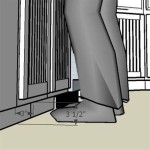Painting Exposed Kitchen Cabinet Hinges: A Comprehensive Guide
Kitchen cabinets are a central element in any kitchen's design. Their appearance significantly influences the overall aesthetic. While much attention is often given to the cabinet doors and frames, the hinges, particularly exposed hinges, can play a crucial role in the final look. Deciding whether to paint exposed hinges is a matter of personal preference and design intent, but proper execution is essential for a professional-looking and durable finish. This article will detail the various considerations, preparation steps, painting techniques, and maintenance tips involved in painting exposed kitchen cabinet hinges.
Exposed hinges, unlike concealed hinges, are visible on the exterior of the cabinet frame and door. This visibility means they contribute to the overall style of the cabinetry. Older cabinets often feature exposed hinges, and they can also be a deliberate design choice to achieve a vintage or rustic aesthetic. Painting these hinges can either blend them seamlessly with the cabinet color or make them stand out as an accent. The decision to paint or leave them as is depends on the desired effect and the existing hardware's finish.
The appearance of exposed hinges can greatly influence the perception of the quality and age of the cabinets. Tarnished or worn hinges can make even newer cabinets appear dated or neglected. Therefore, updating the finish of the hinges, whether by painting, cleaning, or replacing them, is a relatively inexpensive way to refresh a kitchen's appearance. When considering painting, remember that the longevity and durability of the paint job hinge on proper preparation and the selection of appropriate materials.
Understanding the Considerations Before Painting
Before embarking on painting exposed kitchen cabinet hinges, several factors must be carefully considered. These considerations will impact the choice of paint, the required preparation, and the overall success of the project. Ignoring these factors can lead to a subpar finish that is prone to chipping, peeling, or rust.
Firstly, assess the existing material of the hinges. Most kitchen cabinet hinges are made of metal, typically steel, brass, or zinc alloy. Each of these materials requires a slightly different preparation approach and may react differently to various types of paint. For instance, brass hinges may require a specialized primer to ensure proper adhesion. Identifying the material is crucial for selecting the correct products.
Next, evaluate the existing condition of the hinges. Are they heavily corroded, rusted, or coated with layers of old paint? Heavily damaged hinges may require more extensive preparation, such as wire brushing or chemical stripping, to create a smooth and paintable surface. Minor surface imperfections, on the other hand, may be addressed with sanding and priming.
Consider the desired color and finish. Will the hinges be painted to match the cabinets, or will they be a contrasting color? The desired aesthetic will dictate the type of paint and finish to be used. For example, a high-gloss finish will be more reflective and eye-catching, while a matte finish will be more subtle and blend in with the surrounding surfaces. The durability of the finish is also critical, especially in a high-use area like the kitchen. Consider using a durable enamel or epoxy paint for added protection against wear and tear.
Finally, determine whether the hinges will be painted on the cabinets or removed for painting. Removing the hinges will generally result in a more professional and cleaner finish, as it allows for easier access to all surfaces and prevents paint from accidentally getting on the cabinets. However, removing hinges can be time-consuming and may require labeling to ensure they are reinstalled in the correct locations. Painting the hinges while they are still attached to the cabinets is a quicker option but requires careful masking and protection of the surrounding areas.
Preparation: The Key to a Lasting Finish
Proper preparation is arguably the most crucial step in painting exposed kitchen cabinet hinges. A well-prepared surface ensures that the paint adheres properly, resulting in a smooth, durable, and aesthetically pleasing finish. Skimping on preparation will almost certainly lead to problems down the line, such as peeling, chipping, and an overall unprofessional appearance.
The first step in preparation is cleaning. Use a degreaser or mild detergent to thoroughly clean the hinges, removing any grease, dirt, or grime. This step is essential for ensuring proper paint adhesion. Rinse the hinges thoroughly with clean water and allow them to dry completely before proceeding. For hinges that are still attached to the cabinets, be extra careful to avoid damaging the surrounding wood or painted surfaces.
Next, address any existing rust or corrosion. Use a wire brush or sandpaper to remove any loose rust. For heavily corroded hinges, consider using a rust converter to neutralize the rust and prevent it from spreading. Follow the manufacturer's instructions carefully when using rust converters.
Sanding is the next critical step. Even if the hinges are not rusty, sanding will help to create a slightly rough surface that the paint can adhere to. Use a fine-grit sandpaper (around 220-grit) to lightly sand the hinges. If the hinges have a glossy finish, it may be necessary to use a coarser grit sandpaper (around 120-grit) to dull the surface before moving on to the finer grit. Be sure to sand all surfaces of the hinges, including the edges and any recessed areas. After sanding, wipe the hinges clean with a tack cloth to remove any sanding dust.
Priming is an essential step that should not be skipped. Primer provides a uniform base for the paint to adhere to and helps to prevent the paint from being absorbed into the underlying material. Choose a primer that is specifically designed for metal surfaces. Apply a thin, even coat of primer to the hinges, using a brush or spray can. Allow the primer to dry completely according to the manufacturer's instructions before proceeding to the painting stage. If painting attached hinges, carefully mask off the surrounding cabinet areas with painter's tape and drop cloths to protect them from overspray or accidental paint drips.
Painting Techniques and Materials
Once the hinges are properly prepared, the painting process can begin. Selecting the right paint and using the appropriate painting techniques are crucial for achieving a professional-looking and durable finish. The choice of paint will depend on the desired aesthetic, the material of the hinges, and the level of durability required.
Several types of paint are suitable for painting exposed kitchen cabinet hinges. Oil-based paints are known for their durability and smooth finish, but they can be more difficult to work with and require mineral spirits for cleanup. Latex paints are easier to use and clean up with water, but they may not be as durable as oil-based paints. Acrylic enamel paints offer a good balance of durability and ease of use. Spray paints are a convenient option for achieving a smooth and even finish, especially on intricate surfaces. Choose a paint that is specifically designed for metal surfaces and is compatible with the primer that was used.
Apply the paint in thin, even coats. Avoid applying too much paint at once, as this can lead to drips and runs. If using a brush, use smooth, even strokes and avoid overlapping the strokes too much. If using a spray can, hold the can about 10-12 inches away from the surface and apply the paint in a sweeping motion. Overlap each pass slightly to ensure complete coverage. Allow each coat of paint to dry completely before applying the next coat. Two or three thin coats of paint are typically sufficient to achieve a full, even coverage.
If painting attached hinges, be extremely careful to avoid getting paint on the surrounding cabinets. Use high-quality painter's tape to mask off the areas around the hinges. Apply the tape carefully and press it firmly against the surface to prevent paint from seeping underneath. Use drop cloths to protect the countertops and floors from overspray. Consider using a paint shield to further protect the surrounding areas.
After the paint has dried completely, carefully remove the painter's tape. Use a sharp utility knife to score along the edge of the tape before removing it. This will help to prevent the paint from chipping or peeling off with the tape. Inspect the hinges for any imperfections, such as drips or runs. Use a fine-grit sandpaper to lightly sand away any imperfections. Touch up any areas that need it with a small brush.
Once the paint is completely dry and cured, consider applying a clear coat of polyurethane or varnish. This will provide an extra layer of protection against scratches, scuffs, and moisture. Apply the clear coat in thin, even coats, following the manufacturer's instructions. Allow the clear coat to dry completely before reinstalling the hinges (if they were removed). Reinstall the hinges carefully, ensuring that they are properly aligned and secured.

Can Exposed Kitchen Cabinet Hinges Be Painted

Color Outside The Lines Kitchen Inspiration Month Day Four Exposed Hinges

Update Your Kitchen Thinking Hinges Evolution Of Style

The Case For Matching Hinges To Cabinet Color Bean In Love

Color Outside The Lines Kitchen Inspiration Month Day Four Exposed Hinges

Cabinets With Exposed Hinges Design Ideas

Stunning Kitchen Cabinet Details You Ll Want To Copy

Color Outside The Lines Kitchen Inspiration Month Day Four Exposed Hinges

Cabinets With Exposed Hinges Design Ideas

The Case For Matching Hinges To Cabinet Color Bean In Love
Related Posts








